Banking and Finance Law
VerifiedAdded on 2023/06/12
|10
|2785
|376
AI Summary
This article discusses the legislation governing the banking and financial services industry, the relationship between bank and customer, types of payment systems, types of lending practices, and the importance of regulation in lending practices. It also highlights the role of regulators such as ASIC, APRA, and RBA in the banking sector and their effectiveness in the Royal Commission into the Banking Sector.
Contribute Materials
Your contribution can guide someone’s learning journey. Share your
documents today.

RUNNING HEAD: Banking and Finance Law
Banking and Finance Law
Banking and Finance Law
Secure Best Marks with AI Grader
Need help grading? Try our AI Grader for instant feedback on your assignments.
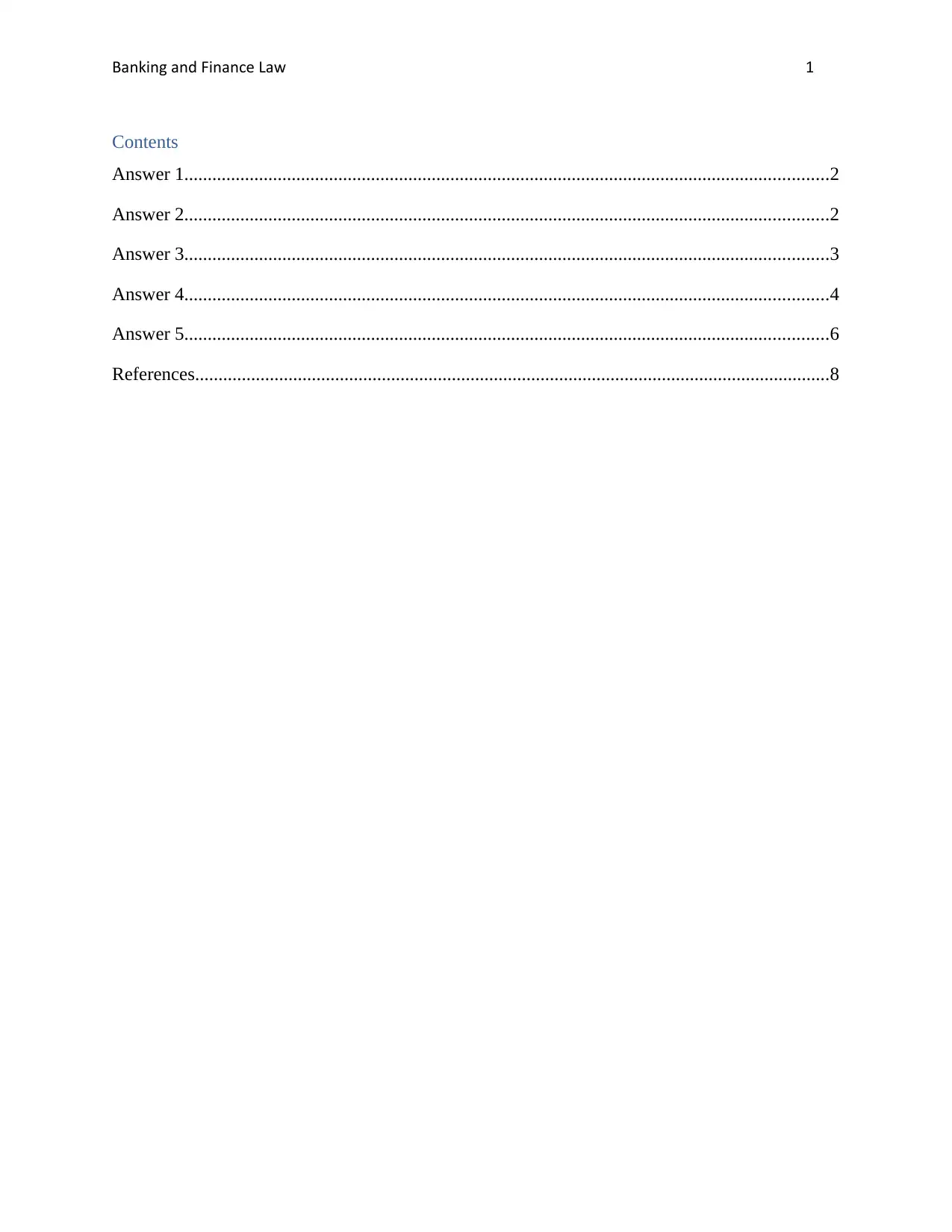
Banking and Finance Law 1
Contents
Answer 1..........................................................................................................................................2
Answer 2..........................................................................................................................................2
Answer 3..........................................................................................................................................3
Answer 4..........................................................................................................................................4
Answer 5..........................................................................................................................................6
References........................................................................................................................................8
Contents
Answer 1..........................................................................................................................................2
Answer 2..........................................................................................................................................2
Answer 3..........................................................................................................................................3
Answer 4..........................................................................................................................................4
Answer 5..........................................................................................................................................6
References........................................................................................................................................8
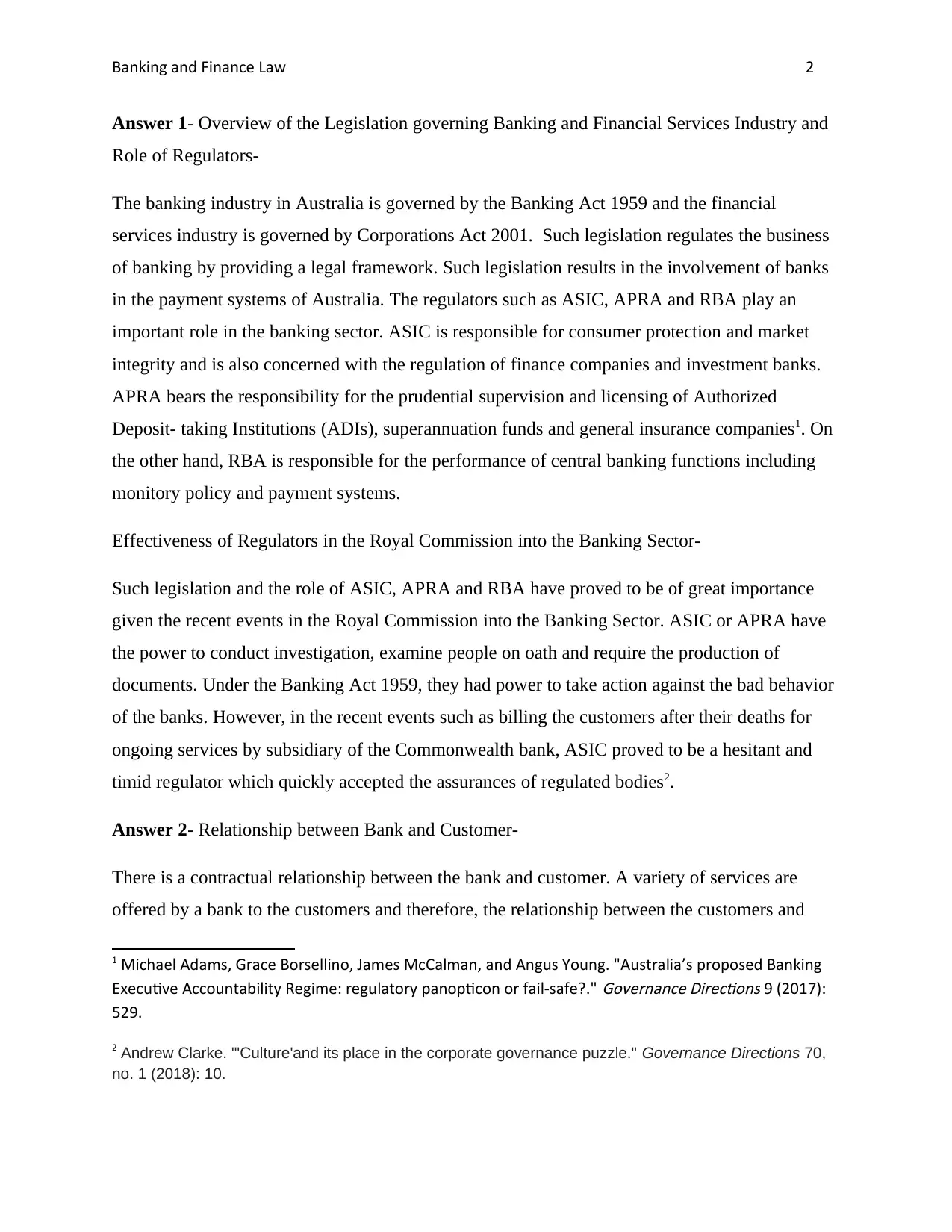
Banking and Finance Law 2
Answer 1- Overview of the Legislation governing Banking and Financial Services Industry and
Role of Regulators-
The banking industry in Australia is governed by the Banking Act 1959 and the financial
services industry is governed by Corporations Act 2001. Such legislation regulates the business
of banking by providing a legal framework. Such legislation results in the involvement of banks
in the payment systems of Australia. The regulators such as ASIC, APRA and RBA play an
important role in the banking sector. ASIC is responsible for consumer protection and market
integrity and is also concerned with the regulation of finance companies and investment banks.
APRA bears the responsibility for the prudential supervision and licensing of Authorized
Deposit- taking Institutions (ADIs), superannuation funds and general insurance companies1. On
the other hand, RBA is responsible for the performance of central banking functions including
monitory policy and payment systems.
Effectiveness of Regulators in the Royal Commission into the Banking Sector-
Such legislation and the role of ASIC, APRA and RBA have proved to be of great importance
given the recent events in the Royal Commission into the Banking Sector. ASIC or APRA have
the power to conduct investigation, examine people on oath and require the production of
documents. Under the Banking Act 1959, they had power to take action against the bad behavior
of the banks. However, in the recent events such as billing the customers after their deaths for
ongoing services by subsidiary of the Commonwealth bank, ASIC proved to be a hesitant and
timid regulator which quickly accepted the assurances of regulated bodies2.
Answer 2- Relationship between Bank and Customer-
There is a contractual relationship between the bank and customer. A variety of services are
offered by a bank to the customers and therefore, the relationship between the customers and
1 Michael Adams, Grace Borsellino, James McCalman, and Angus Young. "Australia’s proposed Banking
Executive Accountability Regime: regulatory panopticon or fail-safe?."
Governance Directions 9 (2017):
529.
2 Andrew Clarke. "'Culture'and its place in the corporate governance puzzle." Governance Directions 70,
no. 1 (2018): 10.
Answer 1- Overview of the Legislation governing Banking and Financial Services Industry and
Role of Regulators-
The banking industry in Australia is governed by the Banking Act 1959 and the financial
services industry is governed by Corporations Act 2001. Such legislation regulates the business
of banking by providing a legal framework. Such legislation results in the involvement of banks
in the payment systems of Australia. The regulators such as ASIC, APRA and RBA play an
important role in the banking sector. ASIC is responsible for consumer protection and market
integrity and is also concerned with the regulation of finance companies and investment banks.
APRA bears the responsibility for the prudential supervision and licensing of Authorized
Deposit- taking Institutions (ADIs), superannuation funds and general insurance companies1. On
the other hand, RBA is responsible for the performance of central banking functions including
monitory policy and payment systems.
Effectiveness of Regulators in the Royal Commission into the Banking Sector-
Such legislation and the role of ASIC, APRA and RBA have proved to be of great importance
given the recent events in the Royal Commission into the Banking Sector. ASIC or APRA have
the power to conduct investigation, examine people on oath and require the production of
documents. Under the Banking Act 1959, they had power to take action against the bad behavior
of the banks. However, in the recent events such as billing the customers after their deaths for
ongoing services by subsidiary of the Commonwealth bank, ASIC proved to be a hesitant and
timid regulator which quickly accepted the assurances of regulated bodies2.
Answer 2- Relationship between Bank and Customer-
There is a contractual relationship between the bank and customer. A variety of services are
offered by a bank to the customers and therefore, the relationship between the customers and
1 Michael Adams, Grace Borsellino, James McCalman, and Angus Young. "Australia’s proposed Banking
Executive Accountability Regime: regulatory panopticon or fail-safe?."
Governance Directions 9 (2017):
529.
2 Andrew Clarke. "'Culture'and its place in the corporate governance puzzle." Governance Directions 70,
no. 1 (2018): 10.
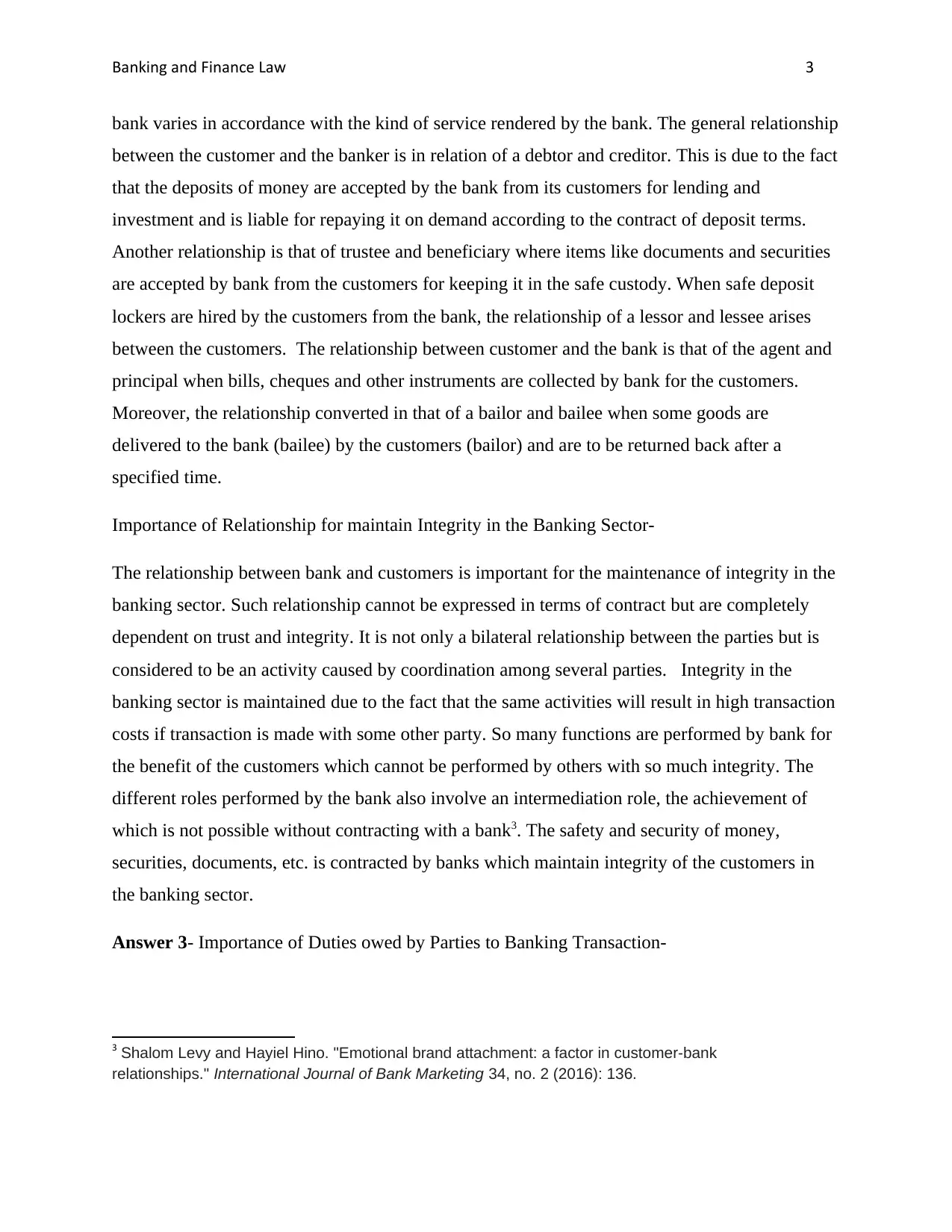
Banking and Finance Law 3
bank varies in accordance with the kind of service rendered by the bank. The general relationship
between the customer and the banker is in relation of a debtor and creditor. This is due to the fact
that the deposits of money are accepted by the bank from its customers for lending and
investment and is liable for repaying it on demand according to the contract of deposit terms.
Another relationship is that of trustee and beneficiary where items like documents and securities
are accepted by bank from the customers for keeping it in the safe custody. When safe deposit
lockers are hired by the customers from the bank, the relationship of a lessor and lessee arises
between the customers. The relationship between customer and the bank is that of the agent and
principal when bills, cheques and other instruments are collected by bank for the customers.
Moreover, the relationship converted in that of a bailor and bailee when some goods are
delivered to the bank (bailee) by the customers (bailor) and are to be returned back after a
specified time.
Importance of Relationship for maintain Integrity in the Banking Sector-
The relationship between bank and customers is important for the maintenance of integrity in the
banking sector. Such relationship cannot be expressed in terms of contract but are completely
dependent on trust and integrity. It is not only a bilateral relationship between the parties but is
considered to be an activity caused by coordination among several parties. Integrity in the
banking sector is maintained due to the fact that the same activities will result in high transaction
costs if transaction is made with some other party. So many functions are performed by bank for
the benefit of the customers which cannot be performed by others with so much integrity. The
different roles performed by the bank also involve an intermediation role, the achievement of
which is not possible without contracting with a bank3. The safety and security of money,
securities, documents, etc. is contracted by banks which maintain integrity of the customers in
the banking sector.
Answer 3- Importance of Duties owed by Parties to Banking Transaction-
3 Shalom Levy and Hayiel Hino. "Emotional brand attachment: a factor in customer-bank
relationships." International Journal of Bank Marketing 34, no. 2 (2016): 136.
bank varies in accordance with the kind of service rendered by the bank. The general relationship
between the customer and the banker is in relation of a debtor and creditor. This is due to the fact
that the deposits of money are accepted by the bank from its customers for lending and
investment and is liable for repaying it on demand according to the contract of deposit terms.
Another relationship is that of trustee and beneficiary where items like documents and securities
are accepted by bank from the customers for keeping it in the safe custody. When safe deposit
lockers are hired by the customers from the bank, the relationship of a lessor and lessee arises
between the customers. The relationship between customer and the bank is that of the agent and
principal when bills, cheques and other instruments are collected by bank for the customers.
Moreover, the relationship converted in that of a bailor and bailee when some goods are
delivered to the bank (bailee) by the customers (bailor) and are to be returned back after a
specified time.
Importance of Relationship for maintain Integrity in the Banking Sector-
The relationship between bank and customers is important for the maintenance of integrity in the
banking sector. Such relationship cannot be expressed in terms of contract but are completely
dependent on trust and integrity. It is not only a bilateral relationship between the parties but is
considered to be an activity caused by coordination among several parties. Integrity in the
banking sector is maintained due to the fact that the same activities will result in high transaction
costs if transaction is made with some other party. So many functions are performed by bank for
the benefit of the customers which cannot be performed by others with so much integrity. The
different roles performed by the bank also involve an intermediation role, the achievement of
which is not possible without contracting with a bank3. The safety and security of money,
securities, documents, etc. is contracted by banks which maintain integrity of the customers in
the banking sector.
Answer 3- Importance of Duties owed by Parties to Banking Transaction-
3 Shalom Levy and Hayiel Hino. "Emotional brand attachment: a factor in customer-bank
relationships." International Journal of Bank Marketing 34, no. 2 (2016): 136.
Secure Best Marks with AI Grader
Need help grading? Try our AI Grader for instant feedback on your assignments.
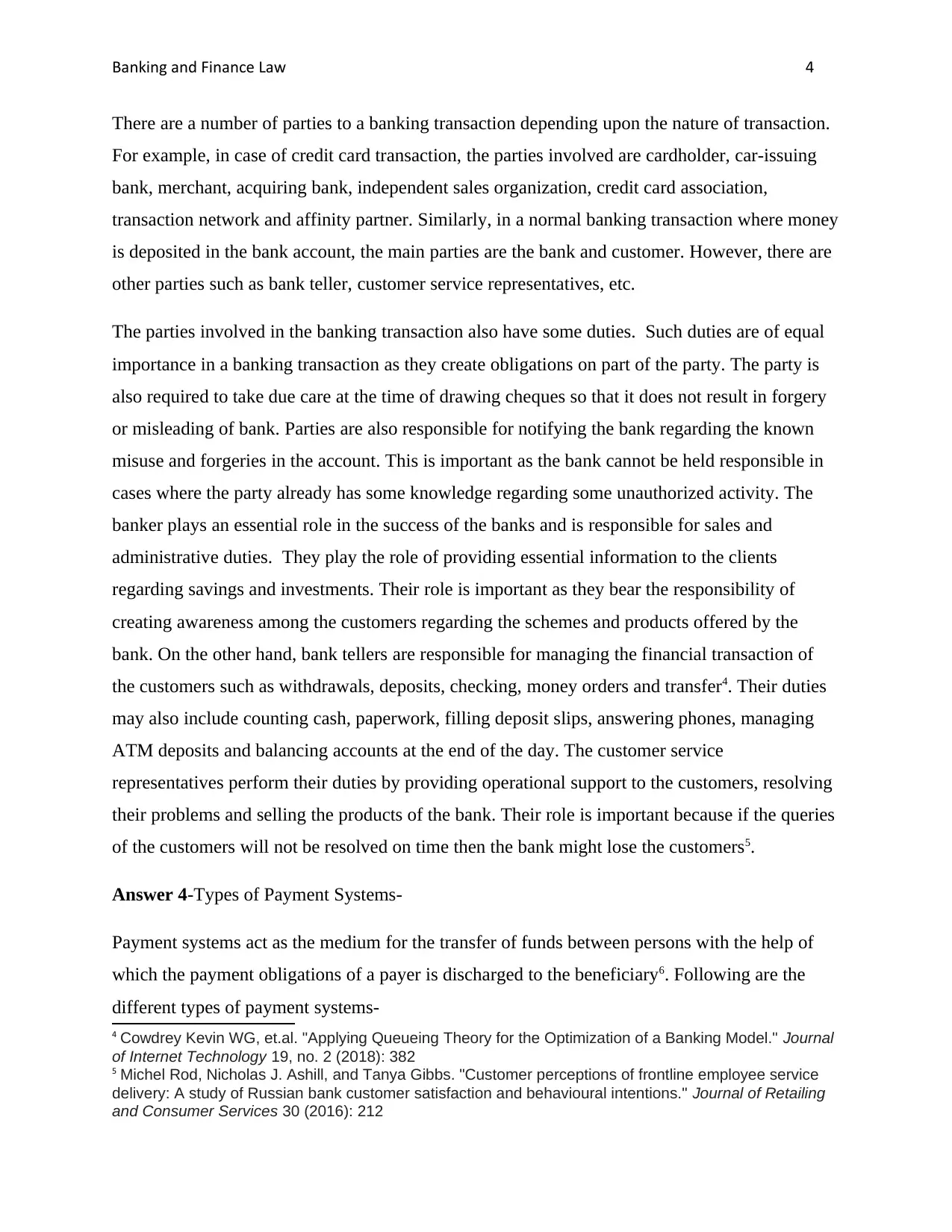
Banking and Finance Law 4
There are a number of parties to a banking transaction depending upon the nature of transaction.
For example, in case of credit card transaction, the parties involved are cardholder, car-issuing
bank, merchant, acquiring bank, independent sales organization, credit card association,
transaction network and affinity partner. Similarly, in a normal banking transaction where money
is deposited in the bank account, the main parties are the bank and customer. However, there are
other parties such as bank teller, customer service representatives, etc.
The parties involved in the banking transaction also have some duties. Such duties are of equal
importance in a banking transaction as they create obligations on part of the party. The party is
also required to take due care at the time of drawing cheques so that it does not result in forgery
or misleading of bank. Parties are also responsible for notifying the bank regarding the known
misuse and forgeries in the account. This is important as the bank cannot be held responsible in
cases where the party already has some knowledge regarding some unauthorized activity. The
banker plays an essential role in the success of the banks and is responsible for sales and
administrative duties. They play the role of providing essential information to the clients
regarding savings and investments. Their role is important as they bear the responsibility of
creating awareness among the customers regarding the schemes and products offered by the
bank. On the other hand, bank tellers are responsible for managing the financial transaction of
the customers such as withdrawals, deposits, checking, money orders and transfer4. Their duties
may also include counting cash, paperwork, filling deposit slips, answering phones, managing
ATM deposits and balancing accounts at the end of the day. The customer service
representatives perform their duties by providing operational support to the customers, resolving
their problems and selling the products of the bank. Their role is important because if the queries
of the customers will not be resolved on time then the bank might lose the customers5.
Answer 4-Types of Payment Systems-
Payment systems act as the medium for the transfer of funds between persons with the help of
which the payment obligations of a payer is discharged to the beneficiary6. Following are the
different types of payment systems-
4 Cowdrey Kevin WG, et.al. "Applying Queueing Theory for the Optimization of a Banking Model." Journal
of Internet Technology 19, no. 2 (2018): 382
5 Michel Rod, Nicholas J. Ashill, and Tanya Gibbs. "Customer perceptions of frontline employee service
delivery: A study of Russian bank customer satisfaction and behavioural intentions." Journal of Retailing
and Consumer Services 30 (2016): 212
There are a number of parties to a banking transaction depending upon the nature of transaction.
For example, in case of credit card transaction, the parties involved are cardholder, car-issuing
bank, merchant, acquiring bank, independent sales organization, credit card association,
transaction network and affinity partner. Similarly, in a normal banking transaction where money
is deposited in the bank account, the main parties are the bank and customer. However, there are
other parties such as bank teller, customer service representatives, etc.
The parties involved in the banking transaction also have some duties. Such duties are of equal
importance in a banking transaction as they create obligations on part of the party. The party is
also required to take due care at the time of drawing cheques so that it does not result in forgery
or misleading of bank. Parties are also responsible for notifying the bank regarding the known
misuse and forgeries in the account. This is important as the bank cannot be held responsible in
cases where the party already has some knowledge regarding some unauthorized activity. The
banker plays an essential role in the success of the banks and is responsible for sales and
administrative duties. They play the role of providing essential information to the clients
regarding savings and investments. Their role is important as they bear the responsibility of
creating awareness among the customers regarding the schemes and products offered by the
bank. On the other hand, bank tellers are responsible for managing the financial transaction of
the customers such as withdrawals, deposits, checking, money orders and transfer4. Their duties
may also include counting cash, paperwork, filling deposit slips, answering phones, managing
ATM deposits and balancing accounts at the end of the day. The customer service
representatives perform their duties by providing operational support to the customers, resolving
their problems and selling the products of the bank. Their role is important because if the queries
of the customers will not be resolved on time then the bank might lose the customers5.
Answer 4-Types of Payment Systems-
Payment systems act as the medium for the transfer of funds between persons with the help of
which the payment obligations of a payer is discharged to the beneficiary6. Following are the
different types of payment systems-
4 Cowdrey Kevin WG, et.al. "Applying Queueing Theory for the Optimization of a Banking Model." Journal
of Internet Technology 19, no. 2 (2018): 382
5 Michel Rod, Nicholas J. Ashill, and Tanya Gibbs. "Customer perceptions of frontline employee service
delivery: A study of Russian bank customer satisfaction and behavioural intentions." Journal of Retailing
and Consumer Services 30 (2016): 212
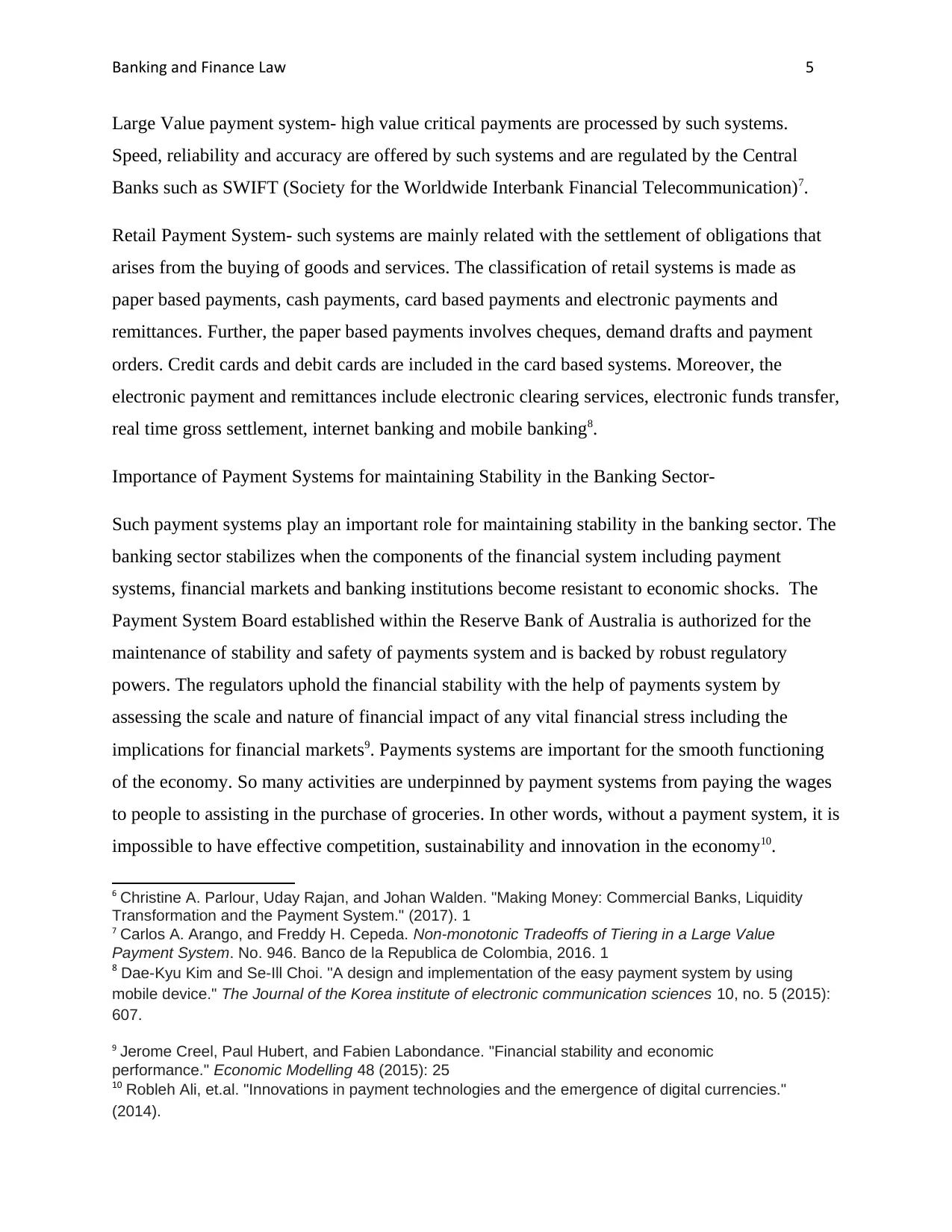
Banking and Finance Law 5
Large Value payment system- high value critical payments are processed by such systems.
Speed, reliability and accuracy are offered by such systems and are regulated by the Central
Banks such as SWIFT (Society for the Worldwide Interbank Financial Telecommunication)7.
Retail Payment System- such systems are mainly related with the settlement of obligations that
arises from the buying of goods and services. The classification of retail systems is made as
paper based payments, cash payments, card based payments and electronic payments and
remittances. Further, the paper based payments involves cheques, demand drafts and payment
orders. Credit cards and debit cards are included in the card based systems. Moreover, the
electronic payment and remittances include electronic clearing services, electronic funds transfer,
real time gross settlement, internet banking and mobile banking8.
Importance of Payment Systems for maintaining Stability in the Banking Sector-
Such payment systems play an important role for maintaining stability in the banking sector. The
banking sector stabilizes when the components of the financial system including payment
systems, financial markets and banking institutions become resistant to economic shocks. The
Payment System Board established within the Reserve Bank of Australia is authorized for the
maintenance of stability and safety of payments system and is backed by robust regulatory
powers. The regulators uphold the financial stability with the help of payments system by
assessing the scale and nature of financial impact of any vital financial stress including the
implications for financial markets9. Payments systems are important for the smooth functioning
of the economy. So many activities are underpinned by payment systems from paying the wages
to people to assisting in the purchase of groceries. In other words, without a payment system, it is
impossible to have effective competition, sustainability and innovation in the economy10.
6 Christine A. Parlour, Uday Rajan, and Johan Walden. "Making Money: Commercial Banks, Liquidity
Transformation and the Payment System." (2017). 1
7 Carlos A. Arango, and Freddy H. Cepeda. Non-monotonic Tradeoffs of Tiering in a Large Value
Payment System. No. 946. Banco de la Republica de Colombia, 2016. 1
8 Dae-Kyu Kim and Se-Ill Choi. "A design and implementation of the easy payment system by using
mobile device." The Journal of the Korea institute of electronic communication sciences 10, no. 5 (2015):
607.
9 Jerome Creel, Paul Hubert, and Fabien Labondance. "Financial stability and economic
performance." Economic Modelling 48 (2015): 25
10 Robleh Ali, et.al. "Innovations in payment technologies and the emergence of digital currencies."
(2014).
Large Value payment system- high value critical payments are processed by such systems.
Speed, reliability and accuracy are offered by such systems and are regulated by the Central
Banks such as SWIFT (Society for the Worldwide Interbank Financial Telecommunication)7.
Retail Payment System- such systems are mainly related with the settlement of obligations that
arises from the buying of goods and services. The classification of retail systems is made as
paper based payments, cash payments, card based payments and electronic payments and
remittances. Further, the paper based payments involves cheques, demand drafts and payment
orders. Credit cards and debit cards are included in the card based systems. Moreover, the
electronic payment and remittances include electronic clearing services, electronic funds transfer,
real time gross settlement, internet banking and mobile banking8.
Importance of Payment Systems for maintaining Stability in the Banking Sector-
Such payment systems play an important role for maintaining stability in the banking sector. The
banking sector stabilizes when the components of the financial system including payment
systems, financial markets and banking institutions become resistant to economic shocks. The
Payment System Board established within the Reserve Bank of Australia is authorized for the
maintenance of stability and safety of payments system and is backed by robust regulatory
powers. The regulators uphold the financial stability with the help of payments system by
assessing the scale and nature of financial impact of any vital financial stress including the
implications for financial markets9. Payments systems are important for the smooth functioning
of the economy. So many activities are underpinned by payment systems from paying the wages
to people to assisting in the purchase of groceries. In other words, without a payment system, it is
impossible to have effective competition, sustainability and innovation in the economy10.
6 Christine A. Parlour, Uday Rajan, and Johan Walden. "Making Money: Commercial Banks, Liquidity
Transformation and the Payment System." (2017). 1
7 Carlos A. Arango, and Freddy H. Cepeda. Non-monotonic Tradeoffs of Tiering in a Large Value
Payment System. No. 946. Banco de la Republica de Colombia, 2016. 1
8 Dae-Kyu Kim and Se-Ill Choi. "A design and implementation of the easy payment system by using
mobile device." The Journal of the Korea institute of electronic communication sciences 10, no. 5 (2015):
607.
9 Jerome Creel, Paul Hubert, and Fabien Labondance. "Financial stability and economic
performance." Economic Modelling 48 (2015): 25
10 Robleh Ali, et.al. "Innovations in payment technologies and the emergence of digital currencies."
(2014).
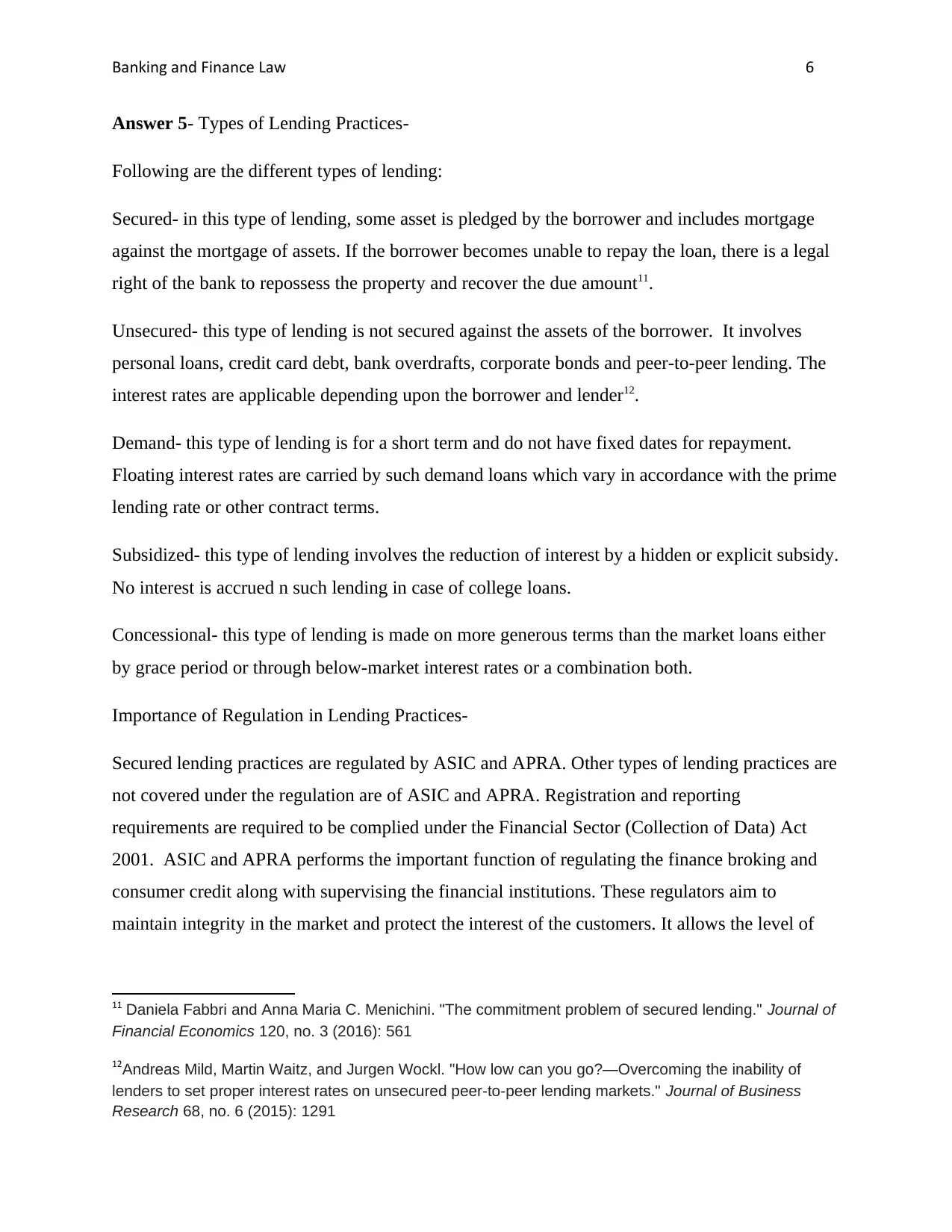
Banking and Finance Law 6
Answer 5- Types of Lending Practices-
Following are the different types of lending:
Secured- in this type of lending, some asset is pledged by the borrower and includes mortgage
against the mortgage of assets. If the borrower becomes unable to repay the loan, there is a legal
right of the bank to repossess the property and recover the due amount11.
Unsecured- this type of lending is not secured against the assets of the borrower. It involves
personal loans, credit card debt, bank overdrafts, corporate bonds and peer-to-peer lending. The
interest rates are applicable depending upon the borrower and lender12.
Demand- this type of lending is for a short term and do not have fixed dates for repayment.
Floating interest rates are carried by such demand loans which vary in accordance with the prime
lending rate or other contract terms.
Subsidized- this type of lending involves the reduction of interest by a hidden or explicit subsidy.
No interest is accrued n such lending in case of college loans.
Concessional- this type of lending is made on more generous terms than the market loans either
by grace period or through below-market interest rates or a combination both.
Importance of Regulation in Lending Practices-
Secured lending practices are regulated by ASIC and APRA. Other types of lending practices are
not covered under the regulation are of ASIC and APRA. Registration and reporting
requirements are required to be complied under the Financial Sector (Collection of Data) Act
2001. ASIC and APRA performs the important function of regulating the finance broking and
consumer credit along with supervising the financial institutions. These regulators aim to
maintain integrity in the market and protect the interest of the customers. It allows the level of
11 Daniela Fabbri and Anna Maria C. Menichini. "The commitment problem of secured lending." Journal of
Financial Economics 120, no. 3 (2016): 561
12Andreas Mild, Martin Waitz, and Jurgen Wockl. "How low can you go?—Overcoming the inability of
lenders to set proper interest rates on unsecured peer-to-peer lending markets." Journal of Business
Research 68, no. 6 (2015): 1291
Answer 5- Types of Lending Practices-
Following are the different types of lending:
Secured- in this type of lending, some asset is pledged by the borrower and includes mortgage
against the mortgage of assets. If the borrower becomes unable to repay the loan, there is a legal
right of the bank to repossess the property and recover the due amount11.
Unsecured- this type of lending is not secured against the assets of the borrower. It involves
personal loans, credit card debt, bank overdrafts, corporate bonds and peer-to-peer lending. The
interest rates are applicable depending upon the borrower and lender12.
Demand- this type of lending is for a short term and do not have fixed dates for repayment.
Floating interest rates are carried by such demand loans which vary in accordance with the prime
lending rate or other contract terms.
Subsidized- this type of lending involves the reduction of interest by a hidden or explicit subsidy.
No interest is accrued n such lending in case of college loans.
Concessional- this type of lending is made on more generous terms than the market loans either
by grace period or through below-market interest rates or a combination both.
Importance of Regulation in Lending Practices-
Secured lending practices are regulated by ASIC and APRA. Other types of lending practices are
not covered under the regulation are of ASIC and APRA. Registration and reporting
requirements are required to be complied under the Financial Sector (Collection of Data) Act
2001. ASIC and APRA performs the important function of regulating the finance broking and
consumer credit along with supervising the financial institutions. These regulators aim to
maintain integrity in the market and protect the interest of the customers. It allows the level of
11 Daniela Fabbri and Anna Maria C. Menichini. "The commitment problem of secured lending." Journal of
Financial Economics 120, no. 3 (2016): 561
12Andreas Mild, Martin Waitz, and Jurgen Wockl. "How low can you go?—Overcoming the inability of
lenders to set proper interest rates on unsecured peer-to-peer lending markets." Journal of Business
Research 68, no. 6 (2015): 1291
Paraphrase This Document
Need a fresh take? Get an instant paraphrase of this document with our AI Paraphraser
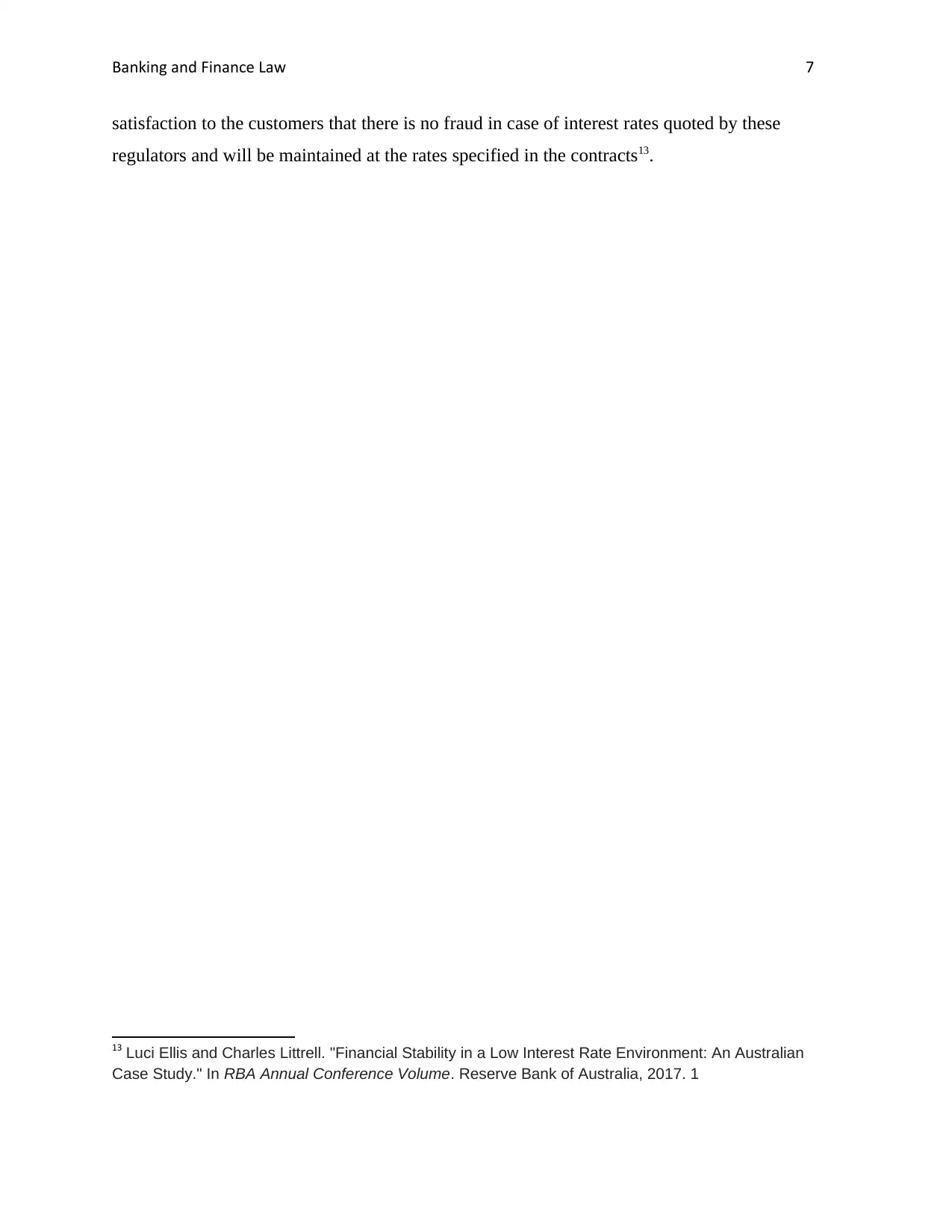
Banking and Finance Law 7
satisfaction to the customers that there is no fraud in case of interest rates quoted by these
regulators and will be maintained at the rates specified in the contracts13.
13 Luci Ellis and Charles Littrell. "Financial Stability in a Low Interest Rate Environment: An Australian
Case Study." In RBA Annual Conference Volume. Reserve Bank of Australia, 2017. 1
satisfaction to the customers that there is no fraud in case of interest rates quoted by these
regulators and will be maintained at the rates specified in the contracts13.
13 Luci Ellis and Charles Littrell. "Financial Stability in a Low Interest Rate Environment: An Australian
Case Study." In RBA Annual Conference Volume. Reserve Bank of Australia, 2017. 1
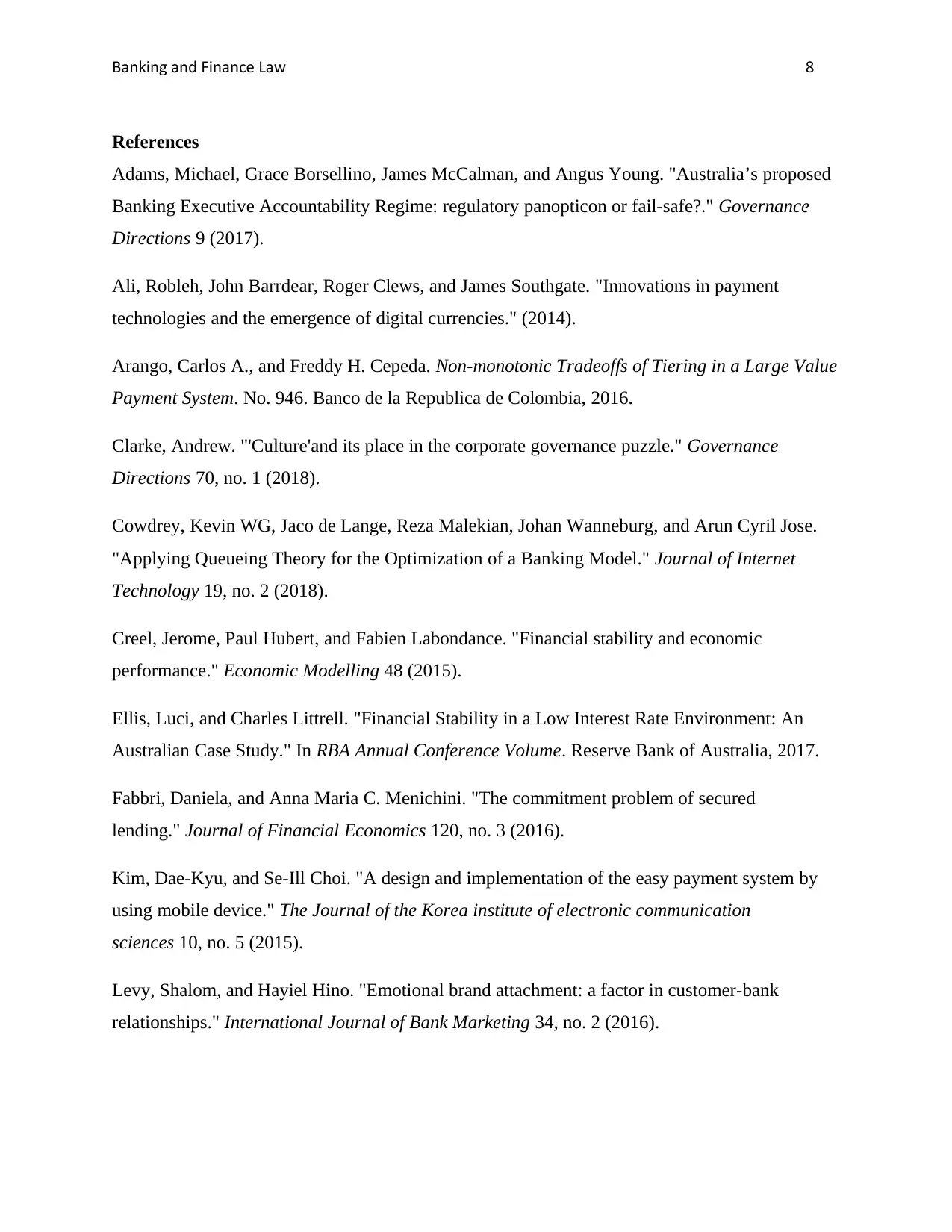
Banking and Finance Law 8
References
Adams, Michael, Grace Borsellino, James McCalman, and Angus Young. "Australia’s proposed
Banking Executive Accountability Regime: regulatory panopticon or fail-safe?." Governance
Directions 9 (2017).
Ali, Robleh, John Barrdear, Roger Clews, and James Southgate. "Innovations in payment
technologies and the emergence of digital currencies." (2014).
Arango, Carlos A., and Freddy H. Cepeda. Non-monotonic Tradeoffs of Tiering in a Large Value
Payment System. No. 946. Banco de la Republica de Colombia, 2016.
Clarke, Andrew. "'Culture'and its place in the corporate governance puzzle." Governance
Directions 70, no. 1 (2018).
Cowdrey, Kevin WG, Jaco de Lange, Reza Malekian, Johan Wanneburg, and Arun Cyril Jose.
"Applying Queueing Theory for the Optimization of a Banking Model." Journal of Internet
Technology 19, no. 2 (2018).
Creel, Jerome, Paul Hubert, and Fabien Labondance. "Financial stability and economic
performance." Economic Modelling 48 (2015).
Ellis, Luci, and Charles Littrell. "Financial Stability in a Low Interest Rate Environment: An
Australian Case Study." In RBA Annual Conference Volume. Reserve Bank of Australia, 2017.
Fabbri, Daniela, and Anna Maria C. Menichini. "The commitment problem of secured
lending." Journal of Financial Economics 120, no. 3 (2016).
Kim, Dae-Kyu, and Se-Ill Choi. "A design and implementation of the easy payment system by
using mobile device." The Journal of the Korea institute of electronic communication
sciences 10, no. 5 (2015).
Levy, Shalom, and Hayiel Hino. "Emotional brand attachment: a factor in customer-bank
relationships." International Journal of Bank Marketing 34, no. 2 (2016).
References
Adams, Michael, Grace Borsellino, James McCalman, and Angus Young. "Australia’s proposed
Banking Executive Accountability Regime: regulatory panopticon or fail-safe?." Governance
Directions 9 (2017).
Ali, Robleh, John Barrdear, Roger Clews, and James Southgate. "Innovations in payment
technologies and the emergence of digital currencies." (2014).
Arango, Carlos A., and Freddy H. Cepeda. Non-monotonic Tradeoffs of Tiering in a Large Value
Payment System. No. 946. Banco de la Republica de Colombia, 2016.
Clarke, Andrew. "'Culture'and its place in the corporate governance puzzle." Governance
Directions 70, no. 1 (2018).
Cowdrey, Kevin WG, Jaco de Lange, Reza Malekian, Johan Wanneburg, and Arun Cyril Jose.
"Applying Queueing Theory for the Optimization of a Banking Model." Journal of Internet
Technology 19, no. 2 (2018).
Creel, Jerome, Paul Hubert, and Fabien Labondance. "Financial stability and economic
performance." Economic Modelling 48 (2015).
Ellis, Luci, and Charles Littrell. "Financial Stability in a Low Interest Rate Environment: An
Australian Case Study." In RBA Annual Conference Volume. Reserve Bank of Australia, 2017.
Fabbri, Daniela, and Anna Maria C. Menichini. "The commitment problem of secured
lending." Journal of Financial Economics 120, no. 3 (2016).
Kim, Dae-Kyu, and Se-Ill Choi. "A design and implementation of the easy payment system by
using mobile device." The Journal of the Korea institute of electronic communication
sciences 10, no. 5 (2015).
Levy, Shalom, and Hayiel Hino. "Emotional brand attachment: a factor in customer-bank
relationships." International Journal of Bank Marketing 34, no. 2 (2016).
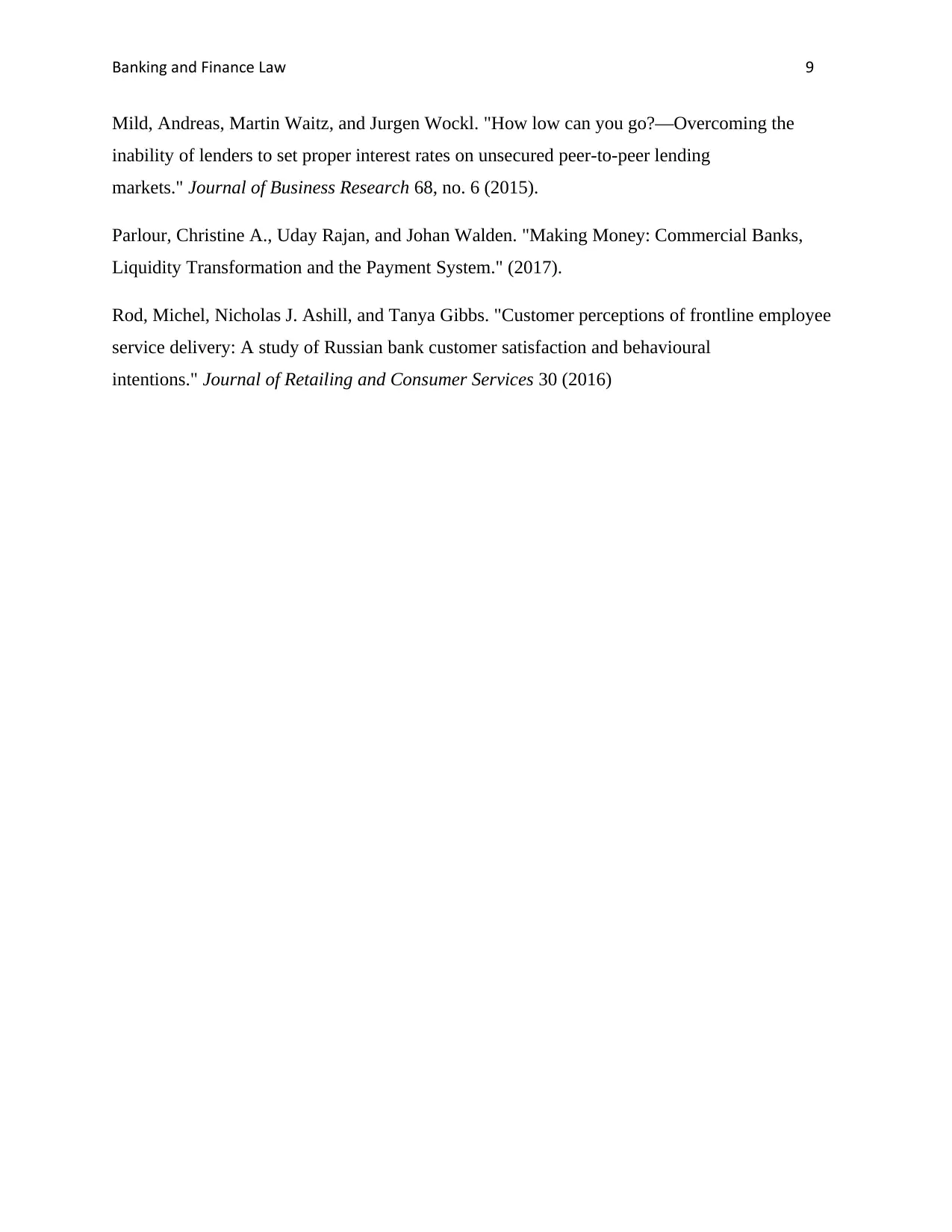
Banking and Finance Law 9
Mild, Andreas, Martin Waitz, and Jurgen Wockl. "How low can you go?—Overcoming the
inability of lenders to set proper interest rates on unsecured peer-to-peer lending
markets." Journal of Business Research 68, no. 6 (2015).
Parlour, Christine A., Uday Rajan, and Johan Walden. "Making Money: Commercial Banks,
Liquidity Transformation and the Payment System." (2017).
Rod, Michel, Nicholas J. Ashill, and Tanya Gibbs. "Customer perceptions of frontline employee
service delivery: A study of Russian bank customer satisfaction and behavioural
intentions." Journal of Retailing and Consumer Services 30 (2016)
Mild, Andreas, Martin Waitz, and Jurgen Wockl. "How low can you go?—Overcoming the
inability of lenders to set proper interest rates on unsecured peer-to-peer lending
markets." Journal of Business Research 68, no. 6 (2015).
Parlour, Christine A., Uday Rajan, and Johan Walden. "Making Money: Commercial Banks,
Liquidity Transformation and the Payment System." (2017).
Rod, Michel, Nicholas J. Ashill, and Tanya Gibbs. "Customer perceptions of frontline employee
service delivery: A study of Russian bank customer satisfaction and behavioural
intentions." Journal of Retailing and Consumer Services 30 (2016)
1 out of 10
Related Documents
Your All-in-One AI-Powered Toolkit for Academic Success.
+13062052269
info@desklib.com
Available 24*7 on WhatsApp / Email
![[object Object]](/_next/static/media/star-bottom.7253800d.svg)
Unlock your academic potential
© 2024 | Zucol Services PVT LTD | All rights reserved.





